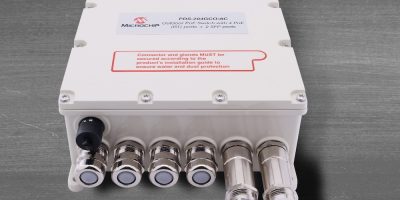Advanced network and security features for outdoor applications are claimed to be delivered by the PDS-204GCO power over Ethernet (PoE) switch from Microchip Technology.
It is the next generation of the PDS-104GO, and additionally offers easy installation and environmental protection, said the company.
PoE switches designed for outdoor use in smart buildings and cities enable services ranging from public Wi-Fi and video surveillance to connected streetlights that require improved reliability and cybersecurity protection. The PDS-204GCO switch adds increased cyber protection and the redundancy required for high network availability in mission-critical applications with long-distance connectivity, said Microchip.
Like the earlier PoE switch, the PDS-204GCO complies with outdoor industry standards and is designed for easy and safe installation but is better able to support applications in which massive amounts of critical data are collected from widely dispersed PoE-powered edge IoT devices. “It addresses these dual challenges of network security and network availability all the way from the endpoint to the central management system,” said Iris Shuker, director of Microchip’s PoE business unit.
PoE technology enables power to be delivered over standard Ethernet infrastructure for quick and easy installation of edge IoT end points. Outdoor PoE switches connect these devices to the network and power them under a broad range of environmental conditions while monitoring and controlling status, including remote reset.
According to Microchip, the PDS-104GO switch is the first to support the industry’s high Ingress Protection 67 (IP67) waterproof rating in these applications while eliminating the need to open the unit during installation and jeopardize safety, performance or reliability. It also adds cybersecurity features for Ethernet networks to protect applications against threats at all network levels, and redundancy features that enable high network availability.
The PDS-204GCO includes four PoE Gigabit Ethernet (GbE) ports that support the IEEE 802.3bt (Type-4) standard and two small form factor pluggable (SFP) fibre links that each support 1Gbit per second or 2.5Gbit per second speeds. The fibre links can be used as optical uplink ports for surveillance cameras and as a redundant uplink path for increasing network availability.
Support for ITU-T G.8032 Ethernet Ring Protection Switching (ERPS) technology ensures communication continues if there is an uplink link failure. The PDS-204GCO switches also supports multiple network topologies, and multiple units can be concatenated using a daisychain topology to extend the reach from the main central switches while reducing the number of optical cables directly connected to it from each device.
Cybersecurity features protect both the data traffic transmitted within the switch and the switch’s system management. Key features for protecting transmitted data within the switch include endpoint device authentication and authorisation, manual switch-traffic policy management, and denial of service (DoS) attack prevention. Key features for protecting switch management and configuration include securing web browsing using self-signed or Certificate Authority (CA)-signed certifications and user authentication and authorisation by remote servers using Radius or TACACS+ security mechanisms.
The PDS-204GCO outdoor PoE switch is based on Microchip’s VSC7514 10-port industrial Ethernet switch, VCS6817 IStaX software package and PoE integrated circuits.
The PDS-204GCO switch is available now.







